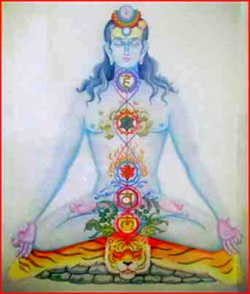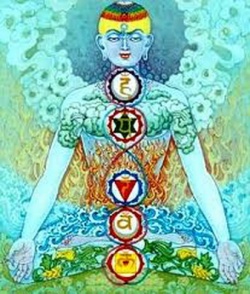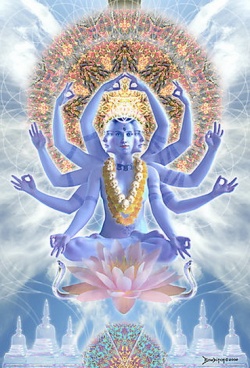Nadi
Nāḍi (tube, pipe") are the channels through which, in traditional Indian medicine and spiritual science, the energies of the subtle body are said to flow. They connect at special points of intensity called chakras.
The word "nadi" is pronounced as "naRdi", with R+d loosely pronounced together (the effort is made by the tip of the tongue, it curls up, pointing backwards, then springs forward to lay flat).
In normal biological reference, a nadi can be translated into "nerve" in English. However, in yogic, and specifically in Kundalini Yoga reference, a nadi can be thought of as a channel (not an anatomical structure).
In regard to Kundalini Yoga, there are three of these nadis: Ida, Pingala, and Sushumna. Ida (spoken "iRda") lies to the left of the spine, whereas pingala is to the right side of the spine, mirroring the ida.
Sushumna runs along the spinal cord in the center, through the seven chakras – Mooladhaar at the base, and Sahasrar at the top (or crown)of the head. It is at the base of this sushumna where the Kundalini lies coiled in three and a half coils, in a dormant or sleeping state.
Early reference
An early version of the nadi system is mentioned in the Katha Upanishad, which says:
"A hundred and one are the arteries of the heart, one of them leads up to the crown of the head. Going upward through that, one becomes immortal." (CU 8.6.6)
One website states:
Nadis are not nerves but rather channels for the flow of consciousness. The literal meaning of nadi is "flow". Just as the negative and positive forces of electricity flow through complex circuits, in the same way, prana shako (vital force) and manas shako (mental force) flow through every part of our body via these nadis. According to the tantras there are 72,000 or more such channels or networks through which the stimuli flow like an electric current from one point to another.
Functions and activities
Nadis are thought to carry a life force energy known as prana in Sanskrit, or qi in Chinese-based systems. In particular prana (active) is supposed to circulate inside Pingala, while apana (passive) is supposed to circulate inside Ida. Inside Sushumna is supposed to circulate kundalini when awakened.
The Ida and Pingala nadis are often seen as referring to the two hemispheres of the brain. Pingala is the extroverted (Active), solar nadi, and corresponds to the right hand side of the body and the left hand side of the brain. Ida is the introverted, lunar nadi, and corresponds to the left hand side of the body and the right hand side of the brain (there is a contralateralization).
These nadis are also said to have an extrasensory function, playing a part in empathic and instinctive responses. The two nadis are believed to be stimulated through different Pranayama practices, including nadi shodhana, which involves alternate breathing through left and right nostrils, which would alternately stimulate respectively the left and right sides of the brain. The word nadi comes from the Sanskrit root
nad meaning "channel", "stream", or "flow".
The rhythmical breathing and special breathing techniques are supposed to influence the flow of these nadis or energetic currents. According to this kind of interpretation (which is the Yoga interpretation) the breathing techniques will purify and develop these two energetic currents and will lead to breathing special exercises whose goal is to awake kundalini among seven Nadi Chakras in our body.
Of the seven, four are in the trunk of the body, two in the head- and there is one in the neck. Chakra is the power center associated with the subtle body of man. Each chakra is ruled by an incarnation of Goddess Parashakti.
Ida, Pingala and Sushumna
Amongst these ducts or nadis, three are of the utmost importance: the Medullar Sushumna, which interpenetrates the cerebro spinal axis from the perineum to the juncture of the lamboid and sagittal suture of the cranium, and it is associated with both nostrils being open and free to the passage of air.
The 'lunar Serpentine Ida' of the left side, of a pale color, negative polarity.
It is associated with feminine attributes, the Yin element of Chinese philosophy, and an open left nostril; the solar Serpentine Pingala of the right side, red color, positive polarity. It is associated with masculine attributes, the Yang element of Chinese philosophy, and an open right nostril. Those are the main nadis, but in some tantric texts more than 72,000 nadis are cited.
They all start from the central channel of the chakras to the periphery, where they gradually become thinner[citation needed].
The Sat-Cakra-Nirupana, one of the earliest texts on nadis and chakra, explicitly refer to these three main nadis, calling them Sasi, Mihira, and Susumna.
In the space outside the Meru, the right apart from the body placed on the left and the right, are the two Nadis, Sasi and Mihira.
The Nadi Susumna, whose substance is the threefold Gunas, is in the middle. She is the form of Moon, Sun, and Fire even water also; Her body, a string of blooming Dhatura flowers, extends from the middle of the Kanda to the Head, and the Vajra inside Her extends, shining, from the Medhra to the Head.
Sushumna (alternatively known as Susumna) Nadi connects the base chakra to the crown chakra.
It is very important in Yoga and Tantra in general. Alternative medicine also refers to Sushumna sometimes. In Raja Yoga or Yoga of Patanjali, when the mind is quietened through Yama, Niyama, Asana and Pranayama the important state of Pratyahara begins.
A person entering this state never complains of Dispersion of Mind. This is characterised by observing the movements/jerks in Sushumna, the central canal in the subtle body. The movements indicate the flow of Prana through the central canal and in the process, the sushumna makes the way for the ascent of Kundalini.
Pingala is associated with solar energy. The word pingala means "tawny" in Sanskrit. Pingala has a sunlike nature and male energy. Its temperature is heating and courses from the left testicle to the right nostril. It corresponds to the river Yamuna. The Ida and Pingala nadis are often seen as referring to the two hemispheres of the brain. Pingala is the extroverted, solar nadi, and corresponds to the left hand side of the brain. Ida is the introverted, lunar nadi, and refers to the right hand side of the brain.
Ida is associated with lunar energy sometime it is based on solar energy. The word ida means "comfort" in Sanskrit. Idā has a moonlike nature and female energy with a cooling effect. It courses from the right testicle to the left nostril and corresponds to the Ganges river. Ida nadi controls all the mental processes while Pingala nadi controls all the [[vital] processes]].
Western tradition and Interpretations
Sometimes the three main nadis (Ida, Pingala and Sushumna) are related to the Caduceus of Hermes: "the two snakes of which symbolize the kundalini or serpent-fire which is presently to be set in motion along those channels, while the wings typify the power of conscious flight through higher planes which the development of that fire confers".
In this framework of mystic western esotericism welded with yoga concepts, sometimes the three nadis are related and named as alchemical sulphur and alchemical mercury.
In the East, the symbol of the two serpents twisting on the rod corresponds to the two currents Pingala and Ida which coil around the Merudanda: the first is red, hot and dry, likened to the Sun and the Alchemic Sulphur; the second, Ida, is cold and wet, like the Alchemic Mercury and is correlated with the Moon for its silver pallor.


